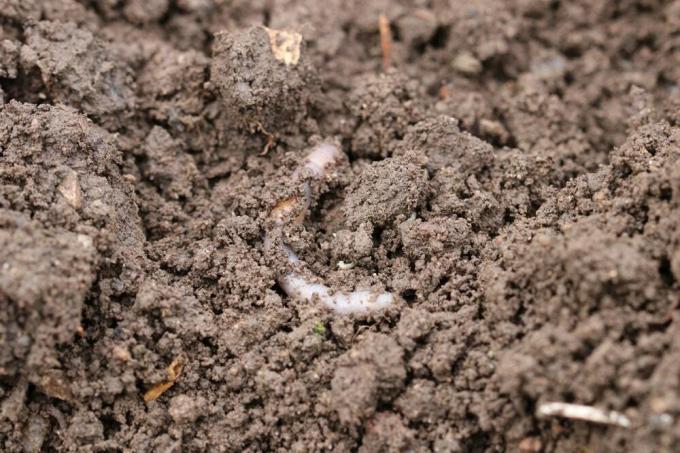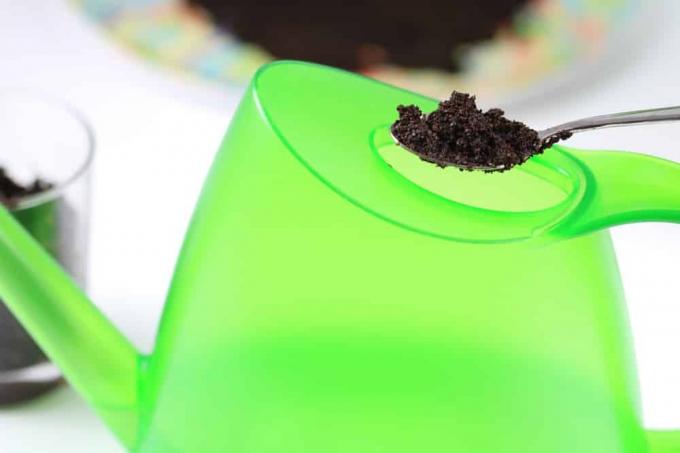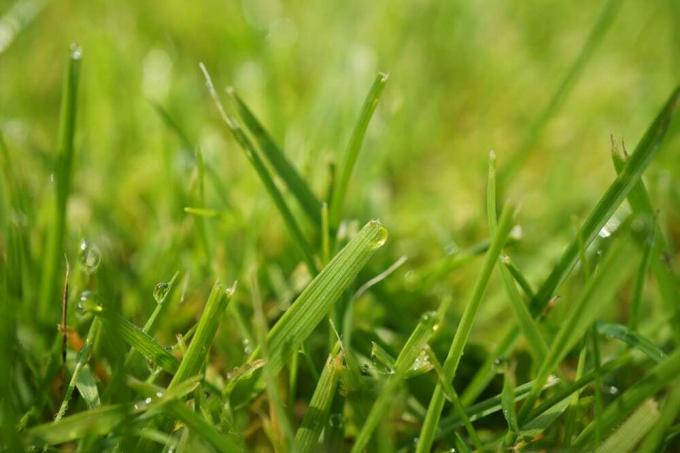

Table of contents
- When is foliar fertilization useful?
- How does foliar fertilizer get into the metabolism of plants?
- Premises and framework conditions at a glance
- Make leaf fertilizer yourself - recipes for home gardeners
- Nettle broth
- Urea - foliar fertilizer from the pharmacy
- Worm farm provides natural foliar fertilizer as a by-product
- Instructions - How to fertilize properly
If plants suffer from a temporary lack of nutrients, root fertilization takes too long to take effect. With foliar fertilization you can compensate for short-term deficiency symptoms in no time at all, because nitrogen, phosphorus and potassium take the direct route into the interior of the plants. The optimal fertilizing effect depends on important factors such as general conditions, composition and administration. This guide explains in detail how to properly fertilize your plants via the foliage. How to make foliar fertilizer yourself.
When is foliar fertilization useful?
In the nutrient supply of ornamental and crop plants, soil fertilization sets the tone because below normal Growing Conditions Nitrogen, phosphorus, potassium and micronutrients are taken up via the roots become. However, this process takes a long time. This is especially true when using organic fertilizers such as compost, stable manure and horn shavings. The nutrients must first be processed by soil organisms until they are available to the plants. It can take weeks and months for your perennials, flowers and vegetables to benefit from the growth spurt.
If an acute nutrient deficiency occurs, you are losing out with an application of organic and mineral-organic fertilizers via the soil. In order to remedy a temporary shortage, the focus is on fast-acting foliar fertilization. We have summarized common reasons for the use of foliar fertilizers below:
- Extreme drought causes nutrient fixation in the soil
- Excess lime in the soil fixes vital iron and triggers leaf chlorosis
- Insufficient fertilization over a long period of time with an overall poor soil condition
- Reduced root activity due to increased seed filling
- Too slow transport of nutrients in times of strong biomass growth
The occurrence of a cause does not mean that foliar fertilization is mandatory. A dry summer is not automatically associated with a blockage of nutrients in the soil. At times of strong growth, existing nutrient reserves in the soil can still cover the needs of the plants for a while. In fact, the measure is only considered if your plants show symptoms of a deficiency. Classic signals are limp, pale or yellowish leaves and clear growth depressions.
How does foliar fertilizer get into the metabolism of plants?
While root strands are programmed to absorb nutrients in both solid and liquid forms, the leaves are not. The epidermis of many plant species is constructed in such a way that scale-like waxy platelets in soft ground tissue reduce water loss due to evaporation. This structure also acts as a barrier to solid fertilizers as well as most dissolved nutrients. Only tiny pores with a maximum diameter of 1 nanometer (0.000001 mm) allow a few low-molecular substances to pass through. Once the dissolved nutrients have overcome this barrier on the leaves, further processing is similar to nutrient uptake via the roots.
If the humidity rises, the base fabric swells together with the embedded wax flakes, so that the pores enlarge. This process improves the ability of the leaves to absorb nutrient solutions.
Premises and framework conditions at a glance

The special form of plant nutrition via the foliage requires specific requirements to be observed. Since fertilizer solutions are essentially nutrient salts, incorrect application can lead to leaf damage. You can effectively prevent burns, leaf necrosis and other defects by only administering foliar fertilizer under the following conditions:
- Overcast weather without direct sunlight
- Under the influence of high humidity, ideally in the evening hours
- Temperatures above 15 degrees Celsius
In the morning hours there is also the desired high humidity due to dew formation. However, the leaf surfaces dry off quickly in the course of the morning and the enlarged leaf pores close. On the other hand, if you administer a foliar fertilizer in the evening hours, there is a sufficiently long time window for nutrient absorption during the night. The effectiveness is optimized by the morning dew formation, because as a result spray coatings that have already dried on the foliage are dissolved again and become available again for the leaf pores.
Tip:
Foliar fertilization cannot replace soil fertilization. Due to the very low concentration of the administered nutrient solution, foliar fertilizers do not have a lasting effect, especially in relation to the main nutrients nitrogen, phosphorus and potassium. However, foliar fertilization has proved its worth as a “fire-fighting measure” with immediate effect.
Make leaf fertilizer yourself - recipes for home gardeners
There are several ways to make foliar fertilizer yourself:
Nettle broth
One of the premium foliar fertilizers in the home garden is a stinging nettle broth. Prepared correctly, the nutrient solution has a concentrated load of nitrogen in its luggage, the engine of growth. How to make your own fertilizer:
Harvest nettles
May to July is the best time to harvest nettles for foliar fertilizer production. Both the stinging nettle (Urtica dioica) and the small stinging nettle (Urtica urens) are suitable, with the latter having the higher nitrogen content. Only pick the leaves of non-flowering plants to avoid getting seeds in the nutrient solution. To protect against the painful stinging hairs, please put on gloves, long trousers and a long-sleeved top. So that you also have a supply of stinging nettles for the production of If you have foliar fertilizers, we recommend harvesting more than current needs and adding excess dry.
make broth
Place the nettle harvest in a large cauldron and pour water over the leaves, just covering them. Put the lid on and let the herbs soak for 24 hours. Then briefly boil the nettle and let everything simmer for 20 minutes. Squeeze out the rich leaves with a tamper, put the lid back on and let the brew cool down. Pour the cooled nettle broth through a sieve. Pure nettle stock should not be sprayed on plant leaves. Your self-produced foliar fertilizer is only ready after dilution with rainwater at a ratio of 1:20. Normal tap water is not suitable for this purpose because it leaves a limescale on the sprayed leaves.
Tip:
Don't feel like harvesting aggressive nettle leaves? Then use the leaves of comfrey, fennel and beetroot to make the foliar fertilizer. Some green highwaymen are also rich in nitrogen, such as speedwell, chickweed, or buttercup.
Urea - foliar fertilizer from the pharmacy
Urea is one of the widely used foliar fertilizers in the home garden. The hygienically safe and non-toxic solid is not only easily soluble in water. In addition, the organic compound has up to 46 percent more nitrogen than other fertilizers. Thanks to its rapid effectiveness, treated plants have absorbed 85 percent of the foliar fertilizer after just 24 hours. A particular advantage is that urea is not a salt, so there is no fear of leaf damage. You can get urea in pharmacies, in health food stores, drugstores and in online shops.
Just 10 grams of urea are enough to turn 1 liter of water into a rich foliar fertilizer. It is important to note that you use collected rainwater or stagnant tap water to avoid limescale deposits on the plants.
Worm farm provides natural foliar fertilizer as a by-product

Operators of a worm farm not only benefit from nutrient-rich worm castings for soil fertilization. A natural liquid fertilizer is produced as a by-product on the lower level. In contrast to commercially available, liquid flower fertilizers, worm tea is suitable for foliar fertilization. As a positive additional effect, the organic liquid fertilizer contains plenty of silicic acid in addition to nutrients and trace elements, depending on the composition of the composted waste. This substance not only strengthens the cell walls of your ornamental and useful plants, but also fights the fungal spores of powdery mildew.
For the production as foliar fertilizer, tap off the worm tea. Dilute the solution with soft water until the color is reminiscent of weak herbal tea. Mist the tops and undersides of the leaves once a week at the recommended setting.
Instructions - How to fertilize properly
The younger the leaves, the thinner the protective wax layer of the epidermis. The absorption rate of the nutrients is correspondingly high. Older leaves have a thicker layer of wax, which requires the use of a wetting agent to allow the nutrient solution to remain on the leaf surface long enough to do its job. In addition to the general conditions explained, the age of the plants must also be taken into account in order to use foliar fertilization professionally. That is how it goes:
- Fertilizer solution for older plants, add a few drops of dish soap to reduce surface tension
- Apply foliar fertilizer by spraying with fine droplets of 0.1 mm to 0.2 mm
- Using the spray method, apply the nutrient solution in droplet sizes of less than 0.1 mm
- Carry out a test spraying on sensitive plants beforehand
The selected application technique determines the dosage. Spray liquid is applied without carrier air and requires a larger droplet size than spray liquid that is transported to the foliage using forced air. If you have decided to spray foliar fertilization, a dosage of 40 milliliters of nutrient solution per square meter of leaf area has proven to be effective in practice. If you use the finer spray method, you can get by with 20 milliliters of solution per square meter that is blown against the foliage.
 garden editorial
garden editorial I write about everything that interests me in my garden.
Learn more about fertilizer

Lawn lime: Lime against moss in the lawn
As soon as moss appears in the lawn, many a hobby gardener becomes restless - because soon the moss carpet can take over entire areas. With lawn lime, however, the unwelcome visitor can be skilfully put in his place.

Build your own Bokashi bucket | DIY instructions
Most of the kitchen waste goes on the compost or in the organic bin to add it back to nature's cycle. But there is a way to gain valuable fertilizer beforehand. We show how easy it is to build a Bokashi bucket and use it to obtain liquid fertilizer on the balcony or even in the apartment.

These 8 plants don't like coffee grounds as fertilizer
Hobby gardeners swear by the effect of the coffee grounds. It is fertilizer, snail protection, soil conditioner and cat deterrent all at the same time. In addition, it is free of charge and occurs daily in the household. Most plants are strengthened, but some are sensitive to the addition of coffee. We clarify.

Fertilize Christmas roses properly: 11 effective home remedies
Christmas roses are special flowers because, unlike almost all other perennials, they bloom in winter. They are insensitive and frost-hardy, and they can also multiply independently. Here you can find out what needs to be considered when fertilizing.

Lawn Bokashi: 6 steps to a cheap & natural fertilizer
The name Bokashi is still largely unknown. This method of using grass clippings comes from Japan. With a little preparation and a special form of processing, the clippings become valuable, nutrient-rich fertilizer that can be easily distributed in the garden.

Wood ash as fertilizer | These 70 plants love barbecue and charcoal
Home gardeners with a fireplace or tiled stove receive a natural fertilizer for free. Charcoal and charcoal leave behind a dusty residue that is packed with valuable nutrients. Read here under what conditions wood ash is suitable as a fertilizer. These 70 plants benefit from the unorthodox nutrient supply.



